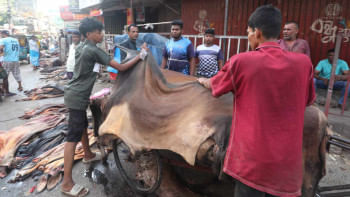Three-domed mosque in Narsingdi: An architectural landmark exuding Mughal-era grandeur

The historic three-domed mosque in Narsingdi stands tall even after around 300 years, and remains a testament to the rich heritage of Muslim architecture from the Mughal era.
Located in Parulia under Palash upazila, the mosque continues to serve as a significant religious and architectural landmark, exuding the grandeur of Mughal craftsmanship.
Historical records indicate that from 1580 to 1722, Narsingdi region was known as Maheshwardi. During that period, large sailboats frequently traversed the Brahmaputra river, attracting onlookers to its banks. The name 'Parulia' is believed to have originated from the local custom of people gathering to watch the boats sail in the river.
Above the entrance to the mosque's veranda, inscriptions in Persian and Bangla scripts provide a brief history of the mosque's construction. According to the inscriptions, the mosque was built in 1128 Hijri, during the 18th century in Gregorian Calendar, by Zaynab Bibi, daughter of Murshid Quli Khan, the then subahdar of Murshidabad and later the first independent nawab of Bengal.
A domed mausoleum with the graves of Zaynab Bibi and her husband Dewan Sharif Khan now lie adjacent to the mosque. Historical accounts indicate that Dewan Sharif Khan had passed away in 1128 Hijri, and after his demise, Zaynab built the mosque.
The mosque's compound spans across 12 bighas of land, featuring four ponds with stone staircases with remarkable 50-foot frames supported by robust stone pillars.
The mosque has a main entrance, three doors on the eastern side, and one door each on the northern and southern sides. On the roof, there are three large domes. The precinct has a fortified boundary wall, housing a spacious courtyard and two towering minarets in the north-east corner.
An earthquake in 1904 caused a crack in the mosque's roof and led to the collapse of Dewan Sharif Khan's administrative residence. The ruins of several ancient graves still exist in the mosque's eastern corner.
Even after around three centuries, hundreds of devotees continue to offer prayers at this mosque and visit the mausoleum.
"Around 200-300 people visit the mosque and offer prayers every day," said Sohel Rana, 32, a local resident.
The mosque and its adjoining structures are maintained by a local management committee, with the four large ponds serving as its primary source of revenue.
Hafez Md Waliullah, imam of the mosque, said the mosque underwent renovations in 1989 after developing structural cracks, and was later restored in 2012 to preserve its historic essence.

 For all latest news, follow The Daily Star's Google News channel.
For all latest news, follow The Daily Star's Google News channel. 



Comments